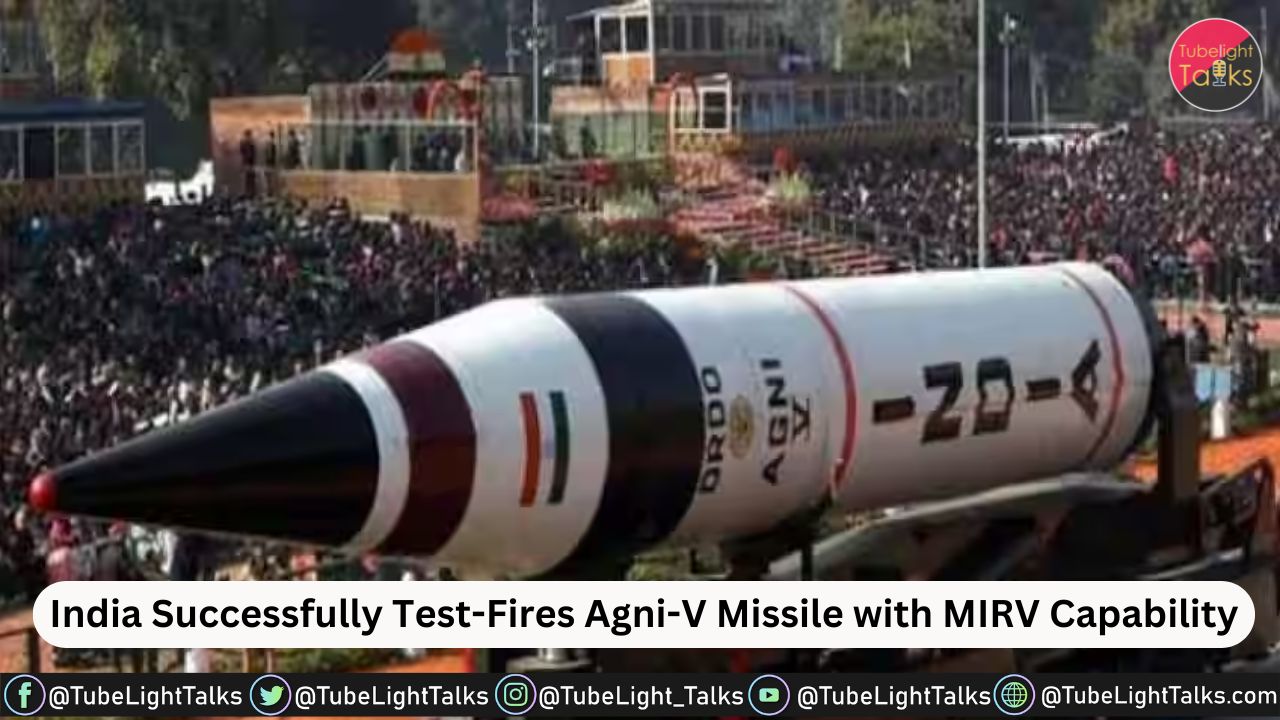In a significant development for India’s defense capabilities, the country successfully test-fired its Agni-V ballistic missile equipped with Multiple Independently Re-entry Vehicle (MIRV) technology. This marks a major milestone as it allows the Agni-V to carry and deploy separate warheads at different targets, significantly enhancing its strategic deterrence capabilities.
India’s Agni-V: Highlights
- India successfully test-fired the Agni-V ballistic missile equipped with MIRV technology.
- This marks a significant milestone in India’s strategic missile program.
- MIRV allows a single missile to carry multiple warheads, enhancing deterrence.
- India remains committed to disarmament and maintaining regional stability.
India Test-Fires Agni-V Missile with MIRV Capability
Successfully test-fired, the Agni-V missile with MIRV capability marks a significant milestone in India’s strategic missile program. Conducted by the Defence Research and Development Organisation (DRDO) under ‘Mission Divyastra,’ this launch integrates a critical advancement: Multiple Independently Targetable Re-entry Vehicle (MIRV) technology.
India’s Agni-V: A Force Multiplier
The Agni-V is a long-range, intercontinental ballistic missile (ICBM) with a range exceeding 5,000 kilometers. This capability positions India as part of an elite group of nations possessing missiles that can reach targets across continents. First tested in April 2012, the Agni-V has undergone several successful trials, solidifying its reliability and operational readiness.
MIRV Technology: Enhanced Precision and Deterrence
The recent test marks a significant leap forward with the incorporation of MIRV technology. MIRV allows a single missile to carry multiple warheads, each independently targeted towards separate locations. This exponentially increases the missile’s destructive potential and complicates enemy defenses. Here’s how MIRV enhances deterrence:
- Increased Threat: A single Agni-V launch poses a threat to multiple targets, forcing adversaries to consider a wider defense network.
- Penetration Potential: MIRVs can overwhelm missile defense systems designed to intercept single warheads.
- Credible Minimum Deterrence: India’s nuclear doctrine emphasizes a “credible minimum deterrence” posture, possessing enough retaliatory power to discourage an attack. MIRV strengthens this doctrine by demonstrating a more versatile and survivable nuclear arsenal.
India’s Agni-V: Implications and Considerations
The successful Agni-V MIRV test carries both strategic and diplomatic weight:
- Strategic Significance: It bolsters India’s position as a regional power with advanced missile technology.
- Diplomatic Considerations: This development might influence regional security dynamics, particularly in the context of India’s relations with neighboring countries with nuclear capabilities.
India’s Agni-V Test: Strengthening Deterrence for Peace
While the Agni-V MIRV test showcases India’s growing defense capabilities, it’s crucial to emphasize the nation’s commitment to disarmament and non-proliferation. India consistently advocates for a global nuclear weapons ban treaty and promotes peaceful uses of nuclear technology.
The Agni-V MIRV development primarily serves as a deterrent, aimed at preventing conflict and maintaining regional stability. DRDO’s success in ‘Mission Divyastra’ signifies India’s continuous efforts to safeguard its national security through strategic advancements while upholding its commitment to global peace.
Charting a Course for Enhanced Security: The Future of India’s Missile Program
India’s strategic missile program is likely to witness further advancements in several areas:
- Enhanced Accuracy: Refining navigation and guidance systems for even greater targeting precision.
- Reduced Launch Time: Minimizing the time between launch detection and warhead impact.
- Mobile Launch Platforms: Developing mobile launchers for increased deployment flexibility.
India’s Agni-V: Balancing Strength with Peace
The successful test of the Agni-V MIRV missile is a testament to India’s technological prowess in the defense sector. While it strengthens the nation’s deterrence capabilities, India’s commitment to global peace and disarmament remains paramount. The future of India’s missile program will likely focus on advancements that enhance strategic security without escalating regional tensions.
Beyond Ballistic Missiles: Satbhakti’s Path to Lasting Peace
While advancements in weaponry like the Agni-V missile might seem necessary in today’s world, true and lasting peace can only be achieved through spiritual understanding. Sant Rampal Ji Maharaj teaches the path of Satbhakti, a devotion based on truth and universal love. By embracing this path, individuals can overcome differences rooted in ego and ignorance. When hearts are filled with compassion and a yearning for the divine, the need for ballistic missiles and worldly conflicts will naturally diminish. If we all seek refuge in the teachings of Sant Rampal Ji Maharaj and strive for inner peace, a world free from violence and division becomes a real possibility. For more information visit jagatgururampalji.org










